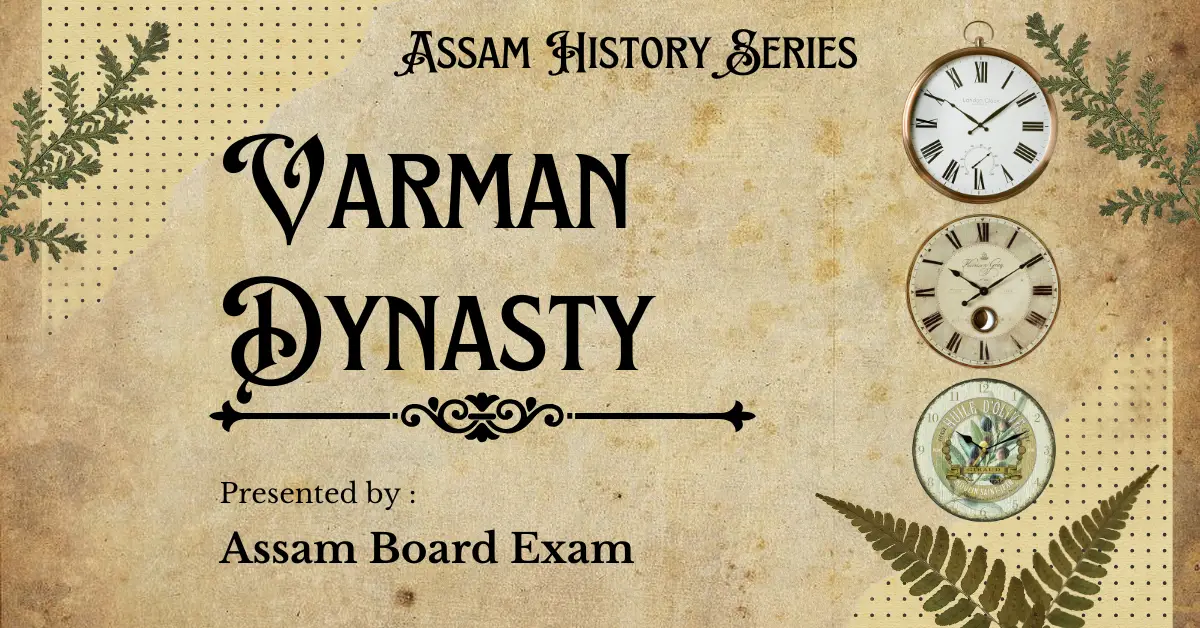The Varman Dynasty was the golden era of ancient Assam, transforming it into a powerhouse of culture, politics, and trade. Stretching from 355 AD to 650 AD, this dynasty gave the region a firm identity and placed it prominently on India’s historical map. From legendary rulers like Pushyavarman to the illustrious Bhaskaravarman, the Varman kings brought prosperity, territorial expansion, and cultural brilliance to the kingdom of Kamarupa.
Dive into this fascinating chapter of Assam’s history and discover how the Varman Dynasty shaped the region’s past.
What Makes the Varman Dynasty Special?
- Unified Assam under strong rulers.
- Expanded territories into Bengal and beyond.
- Promoted cultural and religious harmony.
- Made Assam a significant player in Indian politics.
- Attracted global attention, as seen in Hiuen Tsang’s writings.
Let’s explore the dynasty’s timeline, its rulers, and its incredible achievements!
Origins of the Varman Dynasty
The Varman Dynasty was founded by Pushyavarman in 355 AD. Although not much is known about how he rose to power, his reign marked the beginning of a stable era in Assam’s history. Kamarupa, mentioned in the Allahabad Pillar Inscription of Samudragupta, was already recognized as a powerful frontier kingdom during this period.
Sources of Information:
The history of the Varman Dynasty is preserved in:
- The Dobi Grant
- The Nidhanpur Grant
- The Nalanda Seals of Bhaskaravarman
Key Rulers and Their Achievements
1. Pushya Varman (c. 355–380 AD)
- Founder of the Dynasty: Pushya Varman established the Varman rule in Kamarupa.
- Contemporary of Samudragupta: His reign is referenced in the Allahabad Pillar Prasasti, where Kamarupa and Davaka are mentioned as frontier kingdoms acknowledging Gupta suzerainty.
- Diplomatic Significance: This reference highlights Kamarupa’s importance in Indian geopolitics during the Gupta period.
2. Bala Varman I (c. 405–420 AD)
- Cultural Bridge: His daughter, Amritaprabha, married Meghavahana of Kashmir, linking Assam with Kashmir’s cultural and religious heritage.
- Buddhist Influence: Amritaprabha built Buddhist monuments in Kashmir, showcasing early Buddhist ties in Kamarupa.
3. Kalyana Varman (c. 420–440 AD)
- Military Expansion: Kalyana Varman annexed the Davaka Kingdom (present-day Kapili Valley) into the Kamarupa empire.
- International Ties: Likely sent a diplomatic mission to China, symbolizing Assam’s rising prominence.
4. Mahendra Varman (c. 450–485 AD)
- First Ashwamedha Yajna: Demonstrated his sovereignty and independence from the Guptas.
- Territorial Growth: Extended Kamarupa’s boundaries into Southeast Bengal.
5. Bhuti Varman (c. 510–555 AD)
- Earliest Epigraphic Record: The Badaganga Epigraph, the earliest dated inscription from ancient Assam, belongs to Bhutivarman’s reign.
- Conquests: Expanded Kamarupa’s territories into Bengal, including the Pundravardhana region (modern North Bengal).
- Land Grants: Donated land to over 200 Brahmin families, reflecting his commitment to religion and education.
6. Bhaskara Varman (c. 594–650 AD)
- Crowning Glory of the Dynasty: Bhaskara Varman, also known as Kumara Raja, was the most celebrated ruler of the Varman Dynasty.
- Alliance with Harshavardhana: Sent his ambassador, Hamsavega, to form a strategic alliance with Harsha, which helped overthrow Sasanka of Gauda.
- Hiuen Tsang’s Visit: The Chinese traveler Hiuen Tsang praised Bhaskaravarman’s intellect, diplomacy, and generosity.
- Notable Gift: During Hiuen Tsang’s farewell, Bhaskara presented him with a cap made of skin to protect against rain and cold (Hola-li).
- Cultural Patronage: Issued the Nidhanpur Grants, reaffirming earlier land donations.
Hiuen Tsang’s Description of Kamarupa
Hiuen Tsang’s travelogue, Si-Yu-Ki, offers a fascinating account of Kamarupa during Bhaskaravarman’s reign:
- Geography: A rich, fertile land spanning 1,700 miles, with jackfruit and coconut cultivation.
- People: Small-statured, dark yellow complexion, simple, and hardworking.
- Religion: Predominantly Hindu, with temples dedicated to Devas.
- Military Power: Famous for using elephants in war.
Decline of the Varman Dynasty
- Bhaskaravarman died without an heir, leading to political instability.
- The Salastambha Dynasty, founded by a non-Aryan ruler, rose to power.
Legacy of the Varman Dynasty
The Varman Dynasty laid the foundation for Assam’s rich cultural heritage and political strength. Its rulers fostered a sense of unity, brought Assam into the fold of Indian politics, and ensured cultural exchanges with neighboring regions and countries.
Fun Facts for Students
- Bhaskaravarman offered Hiuen Tsang a rainproof cap made of skin for his travels!
- The dynasty’s capital, Pragjyotishpura, is modern-day Guwahati.
- The famous Nidhanpur Grant confirms over 200 land grants to Brahmins in North Bengal.
Frequently Asked Questions
1. What was the capital of the Varman Dynasty?
The capital was Pragjyotishpura, located in present-day Guwahati, Assam.
2. Who was the greatest ruler of the Varman Dynasty?
Bhaskaravarman (594–650 AD) was the most illustrious ruler, known for his political and cultural achievements.
3. What led to the fall of the Varman Dynasty?
The dynasty ended after Bhaskaravarman’s death due to a lack of an heir, leading to the rise of the Salastambha Dynasty.
SEO-Friendly Keywords for Better Visibility
- Varman Dynasty of Assam
- Bhaskaravarman achievements
- Ancient Assam history
- Kamarupa kings
- Hiuen Tsang in Assam
Summary of the Varman Dynasty
- Period: 355–650 AD, a golden age for Assam.
- Key Sources: Dobi Grant, Nidhanpur Grant, Nalanda Seals.
Major Rulers and Achievements
- Pushyavarman (355–380 AD)
- Established the Varman Dynasty and Kamarupa as a frontier kingdom.
- Recognized as a powerful ally of the Guptas (Allahabad Pillar Inscription).
- Balavarman I (405–420 AD)
- Linked Kamarupa to Kashmir through his daughter Amritaprabha’s marriage.
- Kalyanavarman (420–440 AD)
- Annexed the Davaka Kingdom (Kapili Valley) into Kamarupa.
- Mahendravarman (450–485 AD)
- Performed the first Ashwamedha Yajna, asserting independence from the Guptas.
- Expanded Kamarupa to Southeast Bengal.
- Bhutivarman (510–555 AD)
- Issued the Badaganga Epigraph, the earliest dated inscription of Assam.
- Expanded into Bengal, including Pundravardhana.
- Bhaskaravarman (594–650 AD)
- Formed an alliance with Harshavardhana to overthrow Sasanka.
- Welcomed Hiuen Tsang, who praised Kamarupa’s prosperity.
- Issued the Nidhanpur Grants and gifted Hiuen Tsang a cap of skin.
Hiuen Tsang’s Account
- Described Kamarupa as fertile, prosperous, and militarily strong.
- Predominantly Hindu with a strong reliance on elephants for war.
Decline
- After Bhaskaravarman’s death, the dynasty fell into decline due to lack of an heir.
- The Salastambha Dynasty rose to power, marking the end of the Varman rule.
Conclusion
The Varman Dynasty is a shining chapter in Assam’s history, characterized by strong rulers, cultural brilliance, and territorial expansions. Its legacy continues to inspire pride in the people of Assam, making it an essential topic for students and history enthusiasts alike.
Stay tuned for more engaging articles on Indian history!
Follow Us
Stay connected and updated with our latest offerings by following us on Youtube



